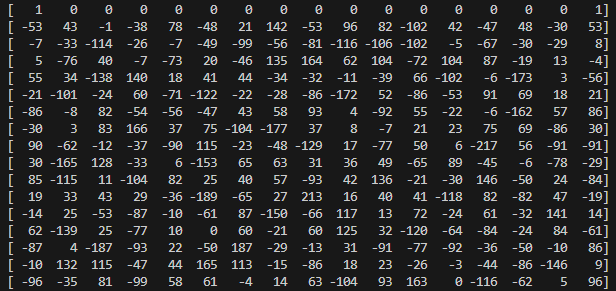WP-[2024.10MoeCTF]hidden_poly
hidden_poly
是一个比较基础的格题,但是我还是一下没做出来...也值得学习记录一下
题目给出的等式即存在 \(k\in\mathbb{Z}\),使得 \[ \sum_{i=0}^{15}key_{i}*root^{i}+kq=0 \]
常规思路
构造格基即 \[ (key_0,key_1,\dots,key_{15},k) \begin{pmatrix} 1 & 0 & 0 & \dots& 0 & root^0\\ 0 & 1 & 0 & \dots& 0 & root^1\\ \vdots & \vdots & \vdots & \ddots & \vdots & \vdots\\ 0 & 0 & 0 & \dots& 1 & root^{15}\\ 0 & 0 & 0 & \dots& 0 & q \end{pmatrix} = (key_0,key_1,\dots,key_{15},0) \] 算一下范数,格基是 \(\sqrt {16} q^{\frac{1}{16}}\) 大概 \(10\) 位,而目标向量按最长算也就是 \(\sqrt{(2^7)^2*16}\) 大概 \(9\) 位,是平衡的
但是这里有一个问题,就是这个格基的最短向量不是目标向量,而是这里的第一行向量 \[ \begin{pmatrix} 1 & 0 & 0 & 0 & \dots & root^0 \end{pmatrix} \] \(root^0\) 即 \(1\),这个向量显然比 \[ (key_0,key_1,\dots,key_{15},0) \] 要短,故规约出来的结果第一个行向量,即最短向量,不是目标向量
规约出来的结果如下

可以看到,第一行向量,即最短向量确实是 \(\begin{pmatrix} 1 & 0 & 0 & 0 & \dots & root^0 \end{pmatrix}\),所以要往下寻找目标向量
第二行中,出现了值为 \(142\) 的分量,超过了 \(key_i\) 的范围 \(0 \sim 2^7\) ,也不是要找的目标向量
第三行的向量分量全都符合范围,应该就是要找的目标向量
但是这里又出现了一个问题,回看刚才构造的格基和等式,可以看到目标向量的最后一个分量应当是 \(0\),但是这里并不是 \(0\),为什么呢?
再次回到等式 \[ \sum_{i=0}^{15}key_{i}*root^{i}+kq=0 \] 展开来写 \[ key_0*root^0+key_{1}*root^{1}+key_{2}*root^{2}+\dots+key_{15}*root^{15}+kq=0 \] 即 \[ key_0+key_{1}*root^{1}+key_{2}*root^{2}+\dots+key_{15}*root^{15}+kq=0 \] 写成这样就能看出来,多出来的值是从哪里来的了:这个多项式只有第一项 \(key_0\) 是在 \(0\sim2^7\) 内,所以其实规约出来的结果,\(key_0\) 的正确值应当是第三行的第一个分量的值减去最后一个分量的值
exp 如下
1 | from Crypto.Util.number import * |
改进思路
既然上面说了,最短的向量是 \(\begin{pmatrix} 1 & 0 & 0 & 0 & \dots & root^0 \end{pmatrix}\),那么可以直接把它避开
有 \[ key_0+key_{1}*root^{1}+key_{2}*root^{2}+\dots+key_{15}*root^{15}+kq=0 \] 则 \[ key_{1}*root^{1}+key_{2}*root^{2}+\dots+key_{15}*root^{15}+kq=-key_0 \] 构造 \[ (key_1,key_2,\dots,key_{15},k) \begin{pmatrix} 1 & 0 & 0 & \dots& 0 & root^1\\ 0 & 1 & 0 & \dots& 0 & root^2\\ \vdots & \vdots & \vdots & \ddots & \vdots & \vdots\\ 0 & 0 & 0 & \dots& 1 & root^{15}\\ 0 & 0 & 0 & \dots& 0 & q \end{pmatrix} = (key_1,key_2,\dots,key_{15}, -key_0) \] 这样还把最后一列规约不出来 \(0\) 的问题一并解决了,是一个改进的方法
exp 如下
1 | from Crypto.Cipher import AES |






![WP-[2024.10MoeCTF]hidden_poly](/2025/03/10/2024MoeCTF-hidden-poly/cover.jpg)

![WP-[2025.1软件系统安全赛]happylock](/2025/01/14/2025%E8%BD%AF%E4%BB%B6%E7%B3%BB%E7%BB%9F%E5%AE%89%E5%85%A8%E8%B5%9B-happylock/cover.jpg)
![WP-[2025.1软件系统安全赛]donntyousee](/2025/01/10/2025%E8%BD%AF%E4%BB%B6%E7%B3%BB%E7%BB%9F%E5%AE%89%E5%85%A8%E8%B5%9B-donntyousee/cover.jpg)